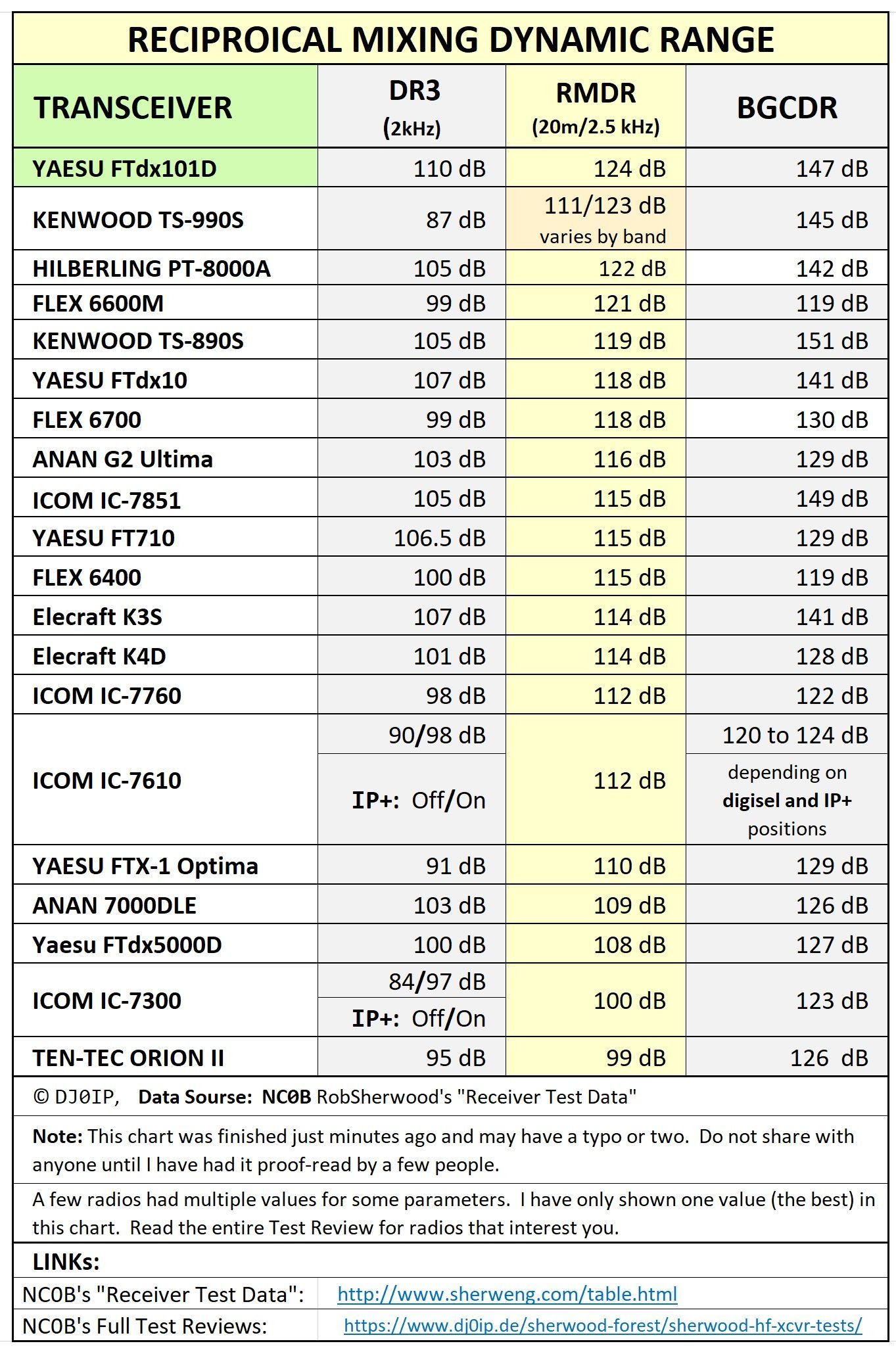TOP 20 RADIO RECEIVERS
Selecting an HF transceiver today based on "Receiver Performance" is a far more difficult task than just looking at a single chart which ranks the radios by one single performance measurement!
Rob Sherwood's (NC0B) "Receiver Test Data" chart has been used by hams for decades to assist in selecting their next radio. HOWEVER, this list, like every list, can only rank radios by one single parameter.
Traditionally, Rob Sherwood has used "Close-In (2 kHz) 2-Tone Dynamic Distortion (DR3) throughout his testing.
There is a lot more to Dynamic Range ranking than just DR3. Besides DR3, there is also "Reciprocal Mixing Dynamic Range" (RMDR) as well as "Blocking Gain Compression Dynamic Range" (BGCDR).
Which is more important? . . .
ALL of them, of course!
We must compare all three of the dynamic range parameters!
Thus, we need THREE (3) Lists!
All of this information is included in Rob Sherwood's RX Test Data list, although RMDR, which was first introduced by ARRL Lab in 2012, must sometimes be computed manually.
Rob's "Full Test Reviews" of newer radios now list RMDR. For older radios, we must compute the RMDR manually by subtracting 27 dB from the Local Oscillator Noise.
(Note: L.O. Noise is the merit of the synthesizer or clock oscillator.)
I have created 3 lists (shown below), ranking today's
Top 20 Radios by the 3 different types of dynamic range measurements.
(Date 3-AUG-2025).
These lists are subject to change as improvements are made to currant radios, or new radios become available.
LIST 1: Ranking by DR3:
Two-Tone Third-Order Inter-modulation Distortion (IMD) Dynamic Range:
The other two test (below) indicate how well the receiver responds when one strong signal outside its passband is present.
DR3 indicates the resistance of the receiver to generating spurious "ghost signals" inside of the passband, caused by multiple strong signals spaced such that they cause non-linearities in the front-end of the receiver.
Since these ghost signals are inside of the passband, they cannot be filtered out!
The 2-tone DR3 test indicates how well the receiver tolerates two nearby strong signals before generating ghost signals.
In today's radios 90+ dB (2 kHz spacing) DR3 is good for normal communications, but in BIG contests (i.e., CQWW DX), 100 dB is better.
LINKs:

LIST 2: Ranking by RMDR:
Reciprocal Mixing is the mixing of the noise generated by the radio's internal circuits, with strong signals outside the passband of the receiver.
This occurs when another strong station is close by, such as multi-multi contest stations or Field Day sites with multiple transmitters.
If RMDR is not ~10 dB higher than the other two dynamic range numbers, it will limit their effectiveness.
A 100+ dB DR3 is meaningless if the RMDR is less than 100 dB!
LINKS:

LIST 3: Ranking by BGCDR:
Blocking Gain Compression Dynamic Range:
This figure depicts the ability of the radio to resist the affect of strong nearby signals, whose desensitizing of the radio causes pumping of the audio.
Good radios today should have at least 100 dB (2 kHz spacing) and 120 dB (20 kHz spacing).
LINKs:

FINDINGS / SUMMARY:
THE OBVIOUS: The ranking is different on each of these lists.
Probably the best example of this is to look closely at the Yaesu FT710.
Although it is much cheaper than the Elecraft K3S and Yaesu FTdx10, it's DR3 is only 1/2 dB lower. Does it perform just as well?
Its RMDR is 3 dB less than the FTdx710 but 1 dB better than the K3S. Looks good so far.
However, its Blocking Gain Compression is only "129 dB"; certainly not bad, but it is
13 dB worse than the K3S and
18 dB worse
than the FTdx10.
This means, on a crowded band as in a Major DX Contest, the FT-710 will overload long before either of the other two radios overload!
* If you ONLY looked at the DR3 of these three radios, you would never know this! *
Here is what GROK3 (AI) says about ARRL Testing, Dynamic Range, and Receiver Performance:
Dynamic Range
- Definition: Dynamic range quantifies a receiver’s ability to handle both weak and strong signals simultaneously without degradation. The third-order dynamic range (DR3) is a key metric, measuring the difference between the noise floor and the signal level where third-order intermodulation distortion (IMD) equals the noise floor. For example, if the noise floor is -128 dBm and IMD appears at -28 dBm, DR3 = 100 dB.
- ARRL Testing Methodology:
- Close-in DR3 (2 kHz spacing): Two signals, 2 kHz apart, are fed into the receiver to measure IMD caused by non-linearities. This is critical for crowded band conditions, such as in CW contests or pile-ups.
- Reciprocal Mixing Dynamic Range (RMDR): Introduced in 2012, RMDR measures how phase noise in the local oscillator affects sensitivity when a strong signal is nearby. A lower RMDR can limit performance, even with high sensitivity, by masking weak signals.
- Historical Context: ARRL stopped publishing third-order intercept point (IP3) data after May 2016 due to changes in receiver technology, as modern receivers often lack the traditional 3:1 IMD ratio.
- Key Findings:
- ARRL tests, often aligned with Rob Sherwood’s (NC0B) methodologies, rank receivers by DR3, but this is not the sole performance indicator. Other factors like RMDR, filter quality, and local oscillator noise are critical.
- A DR3 of 88 dB or higher is considered acceptable for most amateur operations, with top-tier receivers exceeding 100 dB.
- Testing methodology changed in 2007, making direct comparisons between pre- and post-2007 results invalid.
- Practical Implications: High DR3 is vital for contesting or DXing, where strong adjacent signals are common. However, user experiences sometimes diverge from DR3 rankings due to factors like Phase Noise or Filter Performance.
